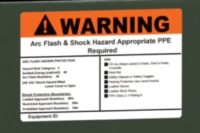Arc flash prediction and prevention myths

Arc flash explosions do not happen… I have never seen one! Seriously? We hope you never will see an arc flash accident. Unfortunately, electrical work by its very nature is dangerous due to the high energy levels involved and, until an accident occurs, electricity is odorless, colorless, and invisible. As an electrical worker, you’ve chosen the third most dangerous profession, according to OSHA. In its article “The Danger of Arc Flash,” July 2009, Fire Engineering magazine said arc flash, “kills two workers a day, every day, year in and year out” and often these accidents "may occur when you perform routine maintenance" so, the likelihood that you will complete your career un-victimized or without knowing an arc flash victim is quite slim.
NFPA-70E is the standard governing arc flash – Well, not really. It’s really about reducing live work by de-energizing a circuit first and putting it in an electrically safe condition before starting to work.
AFH labeling equals compliance with NFPA-70E - To work on any energized equipment above 50 volts, an energized work permit is required. A work permit is critical and cannot be bypassed by a simple labeling system. Employers and management are directly responsible for work permitting, safety programs, training and planning. Article 400.11 Flash Protection states: "Switchboards, panel boards, industrial control panels, and motor control centers that are in other than dwelling occupancies and are likely to require examination, adjustment, servicing, or maintenance while energized shall be field marked to warn qualified persons of potential electric arc flash hazards. The marking shall be located so as to be clearly visible to qualified persons before examination, adjustment, servicing, or maintenance of the equipment." In essence, the Article warns qualified workers of potential danger — it doesn’t give anyone authority or consent to work on energized equipment simply because he or she has complied with the PPE requirements label.
Arc flash analysis is simply panel labeling - Arc flash analysis is about hazard reduction. It is not merely PPE or wardrobe selection.
Assessing equipment under 240 volts from a transformer rated below 125 kVA isn’t necessary - OSHA regulations and NFPA-70E standards mandate all equipment operating at 50 volts and higher must be tested for electrical shock and potential AFH. IEEE 1584 states, “Equipment below 240 V need not be considered unless it involves at least one 125 kVA or larger low-impedance transformer in its immediate power supply.” But this only refers to incident energy calculations. Employers are responsible for assessing all equipment operating at 50 volts and higher for other dangers, including shock and overload conditions, which may cause fire, electrocution, or other hazards.
Regular infrared scans of equipment rule out doing an arc flash analysis - Arc flash can be caused by equipment failure or loose connections, but most injuries are caused by human error and will only be avoided through regular analysis of equipment, work practices, and safety training programs.
Beyond the Motor Control Center (MCC), it isn’t necessary to check equipment for AFH - Just because the MCC is the final access point of power for motor loads, doesn’t mean there isn’t a need to assess other loads, which are fed from it.
Current-limiting fuses reduce most AFH – These don’t thoroughly address the duration component of arc flash. A current-limiting fuse will mitigate AFH only if the fault current is high enough.
There's no AFH if there's no exposed, energized conductors or circuit parts – For most equipment, the probability of an arc flash may be very low, but it’s certainly not impossible. Inserting or removing draw-out circuit breakers, bus plugs and MCC buckets can cause an arc flash where, normally, is no perceived hazard — “normally” operating electrical equipment has been known to fail.
Downstream arc flash hazards are always less violent than upstream arc flash hazards – run a full assessment, up and downstream, don’t stop at hazard level 1 or 2 and be the one who finds out the hard way that this dead wrong.
Sources:
- Kevin Meagher is Chief Technology Officer, Power Analytics Corporation, where he leads the company’s technology development and strategy as well as critical strategic relationships in emerging technologies
- DataCenter Knowledge
Looking for a reprint of this article?
From high-res PDFs to custom plaques, order your copy today!








